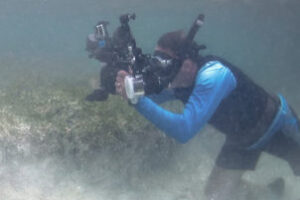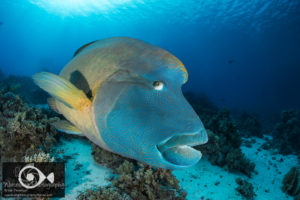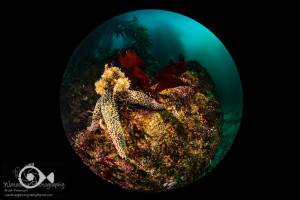A great underwater action shot can be the most challenging objective a photographer faces. Not only does it require that the photographer be thoroughly prepared, but patience and a fair amount of luck are involved as well. Perhaps the easiest of these requirements is being prepared.
#1 Be Prepared
The image above is what we call a “grab shot.” A fast moving animal swims by, and you quickly grab an image and hope for the best. Or do you? This image was taken at the end of my dive as I was completing my safety stop. Previous to this shot, I had been shooting images with a sun-ball and so had my shutter speed high. Before I started my ascent, I changed my camera settings to f/8 and 1/125th just in case something came by. A good rule of thumb to remember is “f/8 and be there,” and a shutter speed matching the conditions (i.e. With or without strobes? Close to the surface or deeper?) In this case, I used ambient light and set my shutter speed so that the water in the background was a beautiful luminescent blue. It only takes a moment to click an image of the blue water to check that your camera settings are correct. If an opportunity swims by, you know it will be exposed correctly.
The key here, is that I prepared ahead of time for the possibility of a grab shot. I had seen some sea lions playing near the surface, and I hoped I would be able to get an action shot of them. Being prepared means that you are aware of what the possibilities are, and before you move on looking for your next subject, you set up your camera for the possibility.
#2 Patience
Wait for it….
Wait for it….
Not yet…
Okay, NOW!
It’s great to get a frog fish yawning, but knowing when the mouth will be open at its widest is the key to getting a “peak of action” shot here. Spend a bit of time observing your subject if it is something that will hang around for a while. This frog fish yawned several times during the thirty minutes or so that I spent with it. It took a lot of patience and a lot of shots to get a keeper.
#3 What Does Luck Have To Do With It?
Luck may have less to do with it than you think. And yet, it is a factor. You can increase your chances of being lucky by being prepared, and increase them even more by studying your subjects. Many subjects will hang around for a while or may even live permanently in a specific place or area of a reef. If you want to get an image of a cardinal fish with a mouth full of eggs, for example, take the time to study the fish. Find out which ones are carrying eggs and what their habits are. Watch them and see how often they aerate the eggs and what the signs are that they are about to spit them out, or move them around.
These Mandarin fish mate at dusk in a predictable pattern. The only bit of “luck” needed here was snapping the shot the moment the eggs were released.
This cormorant along with several others made a number of dives through the huge bait ball they were feeding on. All I had to do was wait for it to come close enough (that was the “luck” factor) for a shot. Once you can identify the patterns of your subjects, you are much more likely to get the money shot: “The Peak of Action!”













